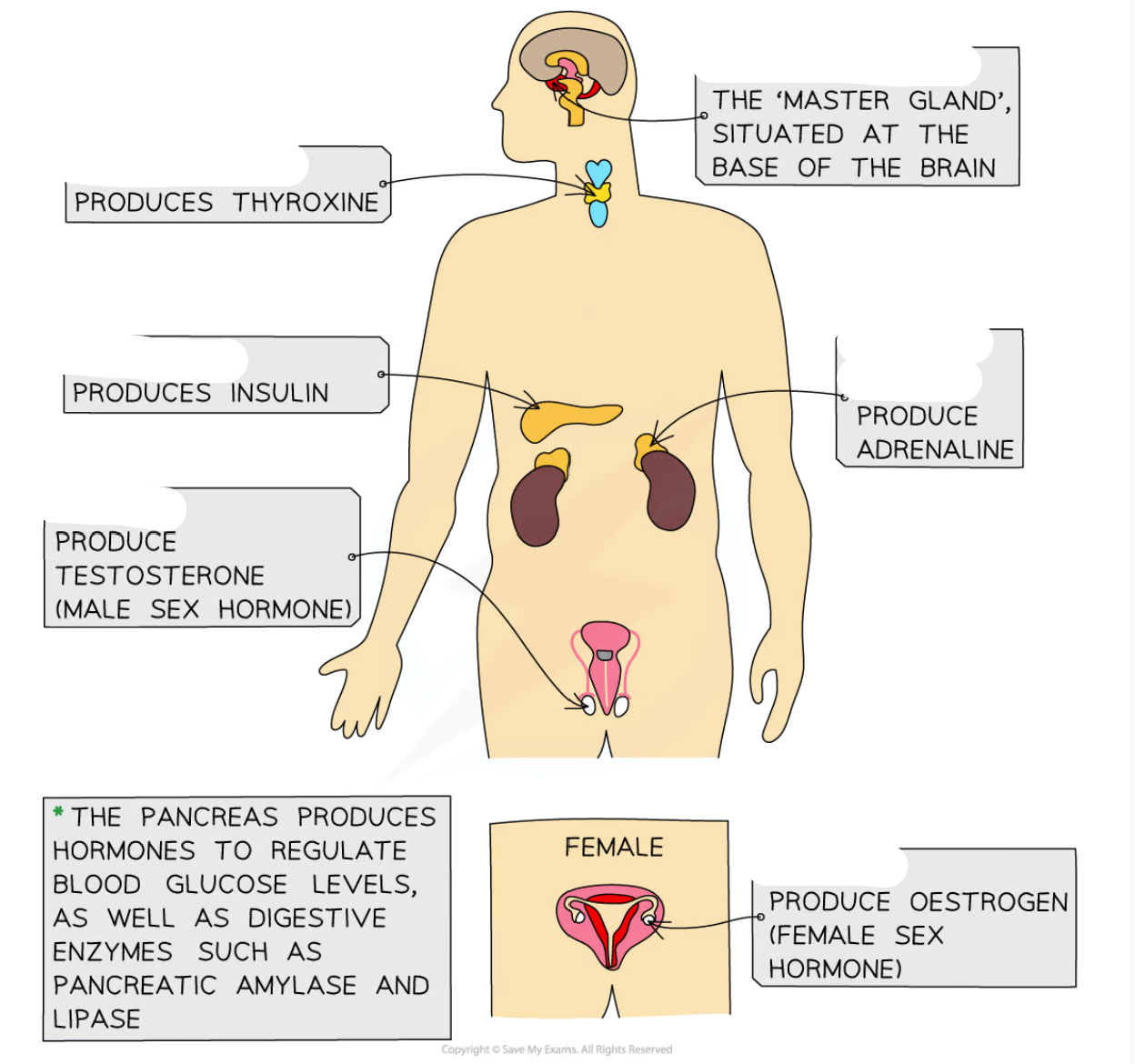Biology Homeostasis - Human hormones
1/26
There's no tags or description
Looks like no tags are added yet.
Name | Mastery | Learn | Test | Matching | Spaced |
|---|
No study sessions yet.
27 Terms
Important structures in the endocrine system are:
Pituitary gland: a ‘master gland’ making hormones such as FSH and LH
Pancreas: produces insulin which regulates the blood glucose level
Thyroid: produces thyroxine which controls metabolic rate and affects growth
Adrenal glands: produces adrenaline
Ovaries (females): produce oestrogen
Testes (males): produce testosterone
Homeostasis
The regulation of internal conditions. Maintains a stable internal environment despite external changes.

Pituitary gland
Thyroid gland
Pancreas
Adrenal gland
Testes
Ovaries
What happens if blood glucose concentration is too high?
The pancreas produces insulin.
Insulin stimulates the liver and muscle cells to convert excess glucose into glycogen for storage.
Type 1 diabetes
The pancreas fails to produce insulin to control blood glucose levels that become too high.
Normally treated with insulin injections.
Type 2 diabetes
The body cells no longer respond to insulin. Insulin is still produced but the body is resistant to it.
Commonly treated with a low carbohydrate diet and regular exercise.
What does the body do when blood glucose levels are too low?
Glucagon is produced which stimulates the liver and muscle cells to convert glycogen into glucose to be released back into the bloodstream.
The digestion of proteins results in excess amino acids. How are they safely excreted?
Deamination - the process of breaking down excess protein - predominantly occurs in the liver.
Enzymes in the liver split up amino acid molecules.
The part containing carbon is turned into glycogen.
The part containing nitrogen is turned into ammonia.
Ammonia is toxic so is converted to urea which is transported via the blood to the kidneys to be excreted.
What is filtered by the kidneys?
Blood flows through at high pressure.
Ultrafiltration - Smaller molecules can pass through the pores and out of the bloodstream. This includes glucose, urea, mineral ions and water.
RBCs and proteins are too big so remain in the blood.
Selective reabsorption
Glucose - all reabsorbed for respiration.
Water - some reabsorbed by osmosis.
Mineral ions - some reabsorbed by diffusion/ active transport
Urea - None reabsorbed.
Contents of urine
urea
excess H2O
Excess ions
What does the body do if water content of the blood is too high?
The pituitary gland releases less ADH into blood.
Tubules of the kidney become less permeable to water.
This leads to less water being reabsorbed by osmosis.
What does the body do if water content of the blood is too low?
The pituitary gland releases more ADH.
This leads to more water being reabsorbed in the tubules of the kidneys as the tubules become more permeable to water.
What are the treatments for kidney faliure?
Dialysis
Kidney transplant
How does a dialysis machine work?
Blood is taken from an artery in the arm.
Inside the machine, the blood and dialysis fluid are separated by a partially permeable membrane.
The blood and dialysis fluid flow in opposite directions to allow exchange to occur where a concentration gradient exists.
Dialysis fluid contains glucose and salt levels similar to the of the blood but no urea.
Waste diffuses into the dialysis fluid and out of the blood.
Disadvantages of kidney transplants
Risk of immune response and rejection if the donor has different antigens on the cell surfaces.
Immunosuppressant drugs have to be taken for the rest of their lives.
Not enough donors to cope with demand.
Simply describe the 28 days of the menstruation cycle
Menstruation - loss of lining from the uterus if no fertilisation has occurred.
Lining starts to thicken.
Ovulation occurs around day 14, the egg travels down the oviduct towards the uterus.
Lining is maintained and ready to accept fertilised egg.
Describe the actions of FSH.
Released by the pituitary gland.
Stimulates development of a follicle in the ovary.
Follicle produces oestrogen.
So FSH stimulates oestrogen production.
Describe the actions of LH.
Released by pituitary gland.
Stimulates ovulation (release of egg) at day 14.
Stimulates ovary to produce progesterone.
Describe the actions of oestrogen.
Produced by the ovaries.
Causes growth and repair of the lining of the uterus.
Inhibits FSH production.
When oestrogen rises to a high level it stimulates the release of LH which causes ovulation.
Post ovulation oestrogen inhibits FSH and LH production.
Describe the actions of progesterone
Produced by corpus luteum (empty egg follicle).
Maintains and thickens the uterus lining.
If egg is not fertilised the the corpus luteum breaks down and progesterone levels drop causing menstruation.
If fertilisation does occur the progesterone continues to be released.
Progesterone inhibits FSH and LH production.
What methods are there to prevent fertilisation?
Use of hormones such as contraceptive pills.
Barrier methods such as contraceptives.
Surgical.
Natural such as abstinence.
How do hormonal contraceptives work?
High levels of oestrogen and progesterone inhibit FSH and LH production therefore preventing the release and maturation of eggs.
What are the issues with fertility treatments?
Done by giving the female FSH and LH. Could also be done using IVF ‘in vitro’ (in glass).
Risk of multiple births is quite high.
Success rate is not very high.
Ethical issues - embryos as potential life.
Negative Feedback
Any movement away from ideal conditions results in changes occurring which bring them back.
Adrenaline
Produced by the adrenal glands in times of fear or stress.
Adrenaline increases heart rate, boosts delivery of oxygen and glucose to the brain and muscles.
Thyroxine
Released from the thyroid gland.
Stimulates basal metabolic rate and protein synthesis.
Controlled by levels of TSH released by pituitary gland.
Too high thyroxine means less TSH released so less thyroxine released.